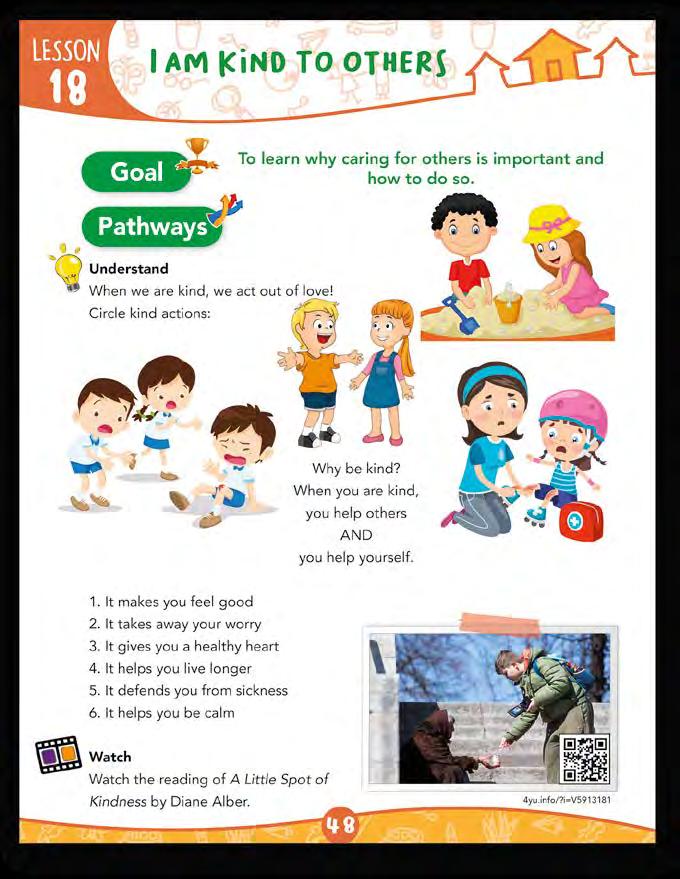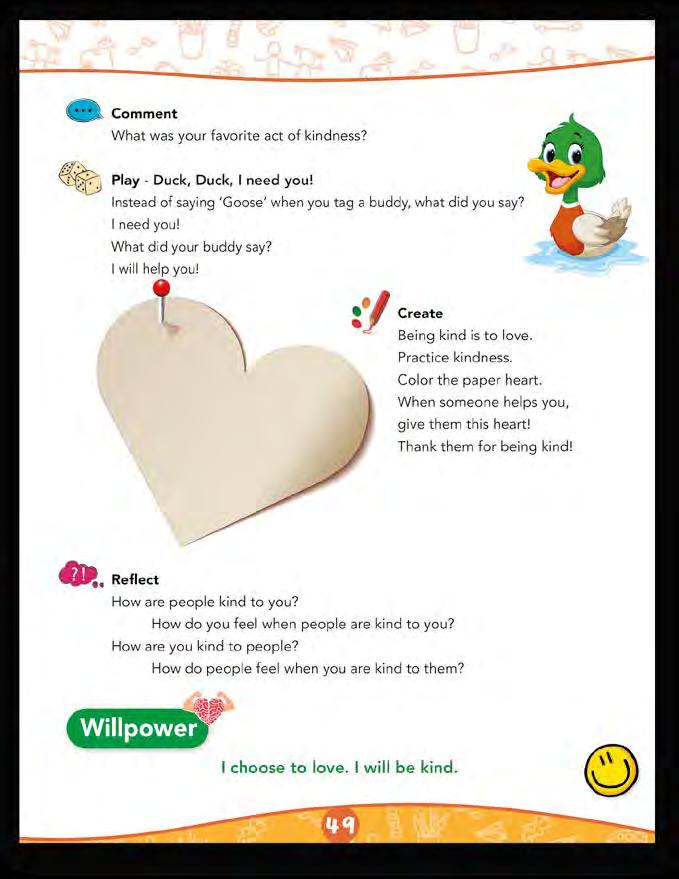
3 minute read
Lesson 3: I Have Senses
Materials
My Best Me textbook, writing and coloring utensils, decorating supplies, construction paper, audiovisual equipment
Advertisement
Resources
Student Worksheet: 4yu.info/?i=V5981318 Family Engagement: 4yu.info/?i=V5981358 Video: 4yu.info/?i=V59813181A Little Spot of Kindness Video
Motivation

Teaching young children to act out of kindness is a foundational skill. Kindness allows them to express love and respect to others, and benefits their relationships, present and future. However, kindness does not only benefit the receiver. Being kind has a powerful positive impact on the individual who is kind. Benefits of kindness include increasing overall happiness levels, improved health and less stress, a greater sense of belonging, improved self-esteem, increased feelings of gratitude, better concentration due to overall increased well-being, less bullying, and reduced depression. The tremendous impact of kindness should be a great motivation for communal effort in promoting kindness all the time. Kindness transforms any learning environment because of increased camaraderie, greater understanding and care between students, and a safe, fun place to grow and learn. Kindness is learned by example and should become the nature of each of your students. When you see unkind behavior in your classroom, you can change the spin. Instead of correcting the student for how they behave, stop them and ask them to start over and do whatever they were doing or saying in a kind way. If it is difficult for them to come up with an idea, ask another student to show how to do and say things in a kind manner.


Goal
Students will discover fun and sincere ways to show care for others.
Pathways
Understand: Instruct your students to circle the kind actions. Explain how kindness allows them to express love and respect to others. Read the list of benefits they will receive when they help others to emphasize that helping others will also help themselves. If ever it crosses a student’s mind that some people are just not nice and do not deserve kind treatment, these personal benefits for being kind should be a wonderful motivation to still be kind, no matter what.

Watch: Play the video for all students to see. Ask comprehension questions. Allow students to ask questions and make comments. Play a second time for reinforcement purposes, as desired. Comment: Read the comprehension question based on the previous video viewing. Discuss the students’ thoughts. Emphasize the value of care, and how it impacts others’ lives. Play: Tell students that they will play a special version of “Duck, Duck, Goose!” This helps them practice asking for and offering help. All the students, except the first person who is “it”, sit in a circle. The “it” student walks around the circle, tapping each player on the head, saying “duck” each time until they decide to tap someone and say “I need you!” That student must shout “I will help you!” in response to being selected and run after the student that is “it”, trying to tag them before they can run around the circle of students and take the selected student’s seat. If the “it” student is able to reach the selected student’s seat without being tagged, the selected student is the new “it”. If the selected student tags the “it” student, then the selected student keeps his spot in the circle and the “it” student must either continue to be “it” for another turn or sit in the middle of the circle until another student is selected to be “it”. Create: Help your students practice kindness and show love by creating a heart. Pass out a piece of paper to each student. Instruct the class to do the following: 1. Fold the piece of paper in half. 2. Draw a half-heart shape along the folded edge of the paper. 3. Cut the heart out. 4. Decorate the paper heart. Tell the students to hold onto the heart and give it to someone who helps them, and thank them for being kind. Reflect: Read the questions. Give students time to think, and raise their hands when they think of a personal example they can describe to the class. Share fitting examples yourself, as needed.

Willpower
Ask students if they think their classmates should always be kind. If yes then have them understand they themselves should always be kind. Repeat the Willpower statement as a class. Decide on hand motions that accompany it. Repeat it with the motions as a class.



